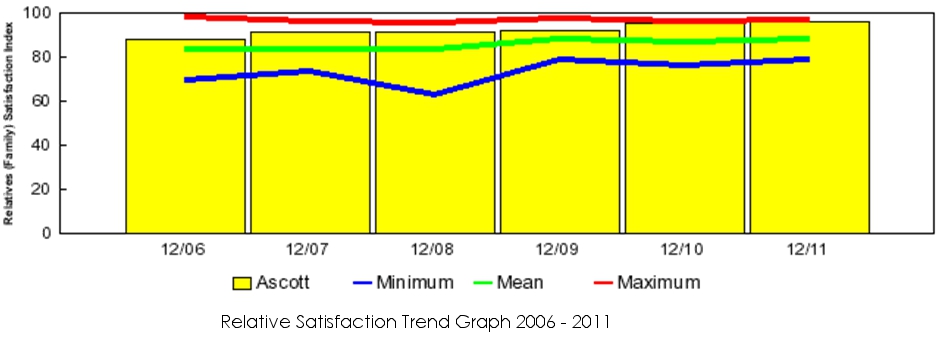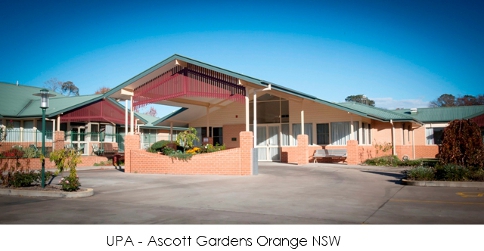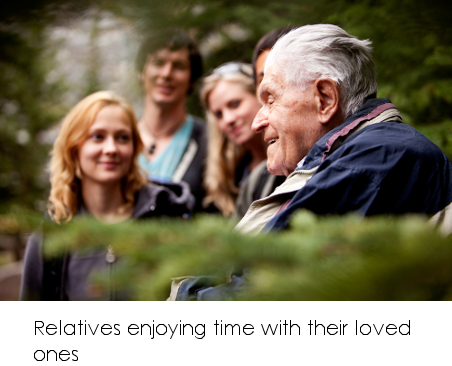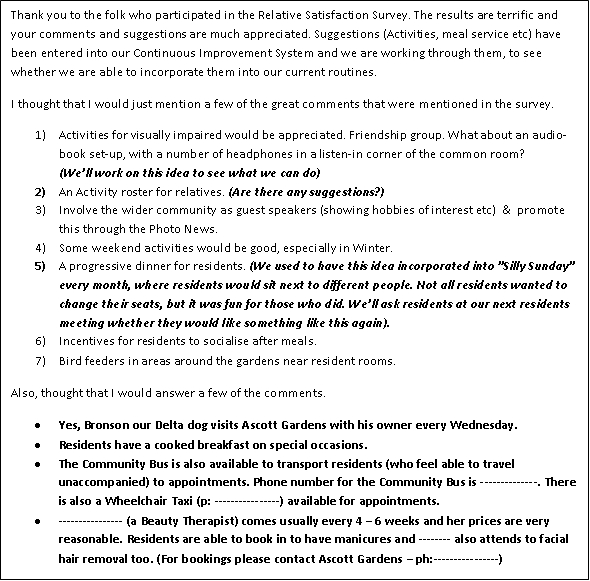Achieving High Participation Rates in Relative Satisfaction Surveys
Achieving High Participation Rates in Relative Satisfaction Surveys - Ascott Gardens UPA
It is hard to manage a business without having a good knowledge or understanding of your customer's needs and perceptions. Health and Aged Care are no exceptions to this rule. Of course obtaining customer satisfaction in aged care has complexities that are rarely encountered in other markets. For example, there are few businesses where the average age of the customer might be 80+ years of age, or where a significant proportion of the client base might be suffering from varying levels of dementia. Whilst we might dwell on the difficulties, we should also consider some of the more positive opportunities. For instance, the clients are usually clients for a long period of time and the relationship is often quite close with a degree of co-dependence.Ascott Gardens is a 62 bed ageing in place facility in Orange, located in the Central West Region of NSW. It has 38 general beds and two twelve bed specific dementia units. Ascott Gardens is owned and operated by the United Protestant Association of NSW. It has a long history of benchmarking with QPS and over this time Ascott Gardens has achieved very high levels of resident and relative satisfaction.

What is not quite so obvious in the reported benchmarking results is that Ascott Gardens has, over the past three years, achieved a constantly high rate of relative participation in the surveys with approximately 55-60% return rates based on the ratio of surveys submitted to total bed numbers. When you take into account less than 100% occupancy and some residents not having relatives then the ratio of survey returns to available relatives is sometimes considerably higher.
In the most recent mid-year survey (August 2012) there were 35 responses from a targeted number of 36 relatives to give a very impressive 97.22% response rate to the target. Each year the facility plans to survey 20 of the resident's families in the three Cottages (general section), and 16 resident families in the two Lodges (specific dementia units).

Margaret also explains that many years ago she was impressed by the words of Jean McCoy in a previous QPS article on employee satisfaction where Jean claimed that "the residents would never be happier than the staff". Margaret believes that what Jean said was right and that the behaviour and attitudes of staff set the scene for resident and relative participation in surveys and overall satisfaction results.
Right from the staff induction we impress upon our staff the importance of greeting residents and relatives with a smile. At every staff meeting we try to reinforce the four core values of UPA: kindness; compassion; integrity; and, respect. Over the years we have witnessed that the more comfortable residents are with our staff, the more open they are when it comes to making suggestions, complaints or providing feedback via the survey processes.
Management at Ascott Gardens has found that when seeking higher levels of participation in relative satisfaction surveys it is important to both listen to and understand the needs of those being surveyed.

"At first we were so keen to get feedback that we tried to survey every relative twice a year. From the relatives perspective this was overkill" says Margaret.
Through discussion and modification of our program, we now survey the relatives of all new residents plus approximately 50% of the rest. This gives us a healthy 55-60%+ rate for sixty residents and relatives no longer suggest that they are being surveyed too much. Margaret suggests that each organisation may need to find its own level of comfort but insists that a stable and high percentage rate is more likely to provide the best opportunities for improvement.
Before the surveys are circulated, Team Leaders advise residents and relatives of the upcoming survey and the opportunity to participate. Residents and relatives are always asked if they would like to participate, but they are not compelled to do so.
Our two Team Leaders prepare the surveys, and place them in a large yellow envelope, with a stamped addressed return envelope included. Surveys are distributed in person, or posted (with a phone call prior) or emailed... whatever is the most convenient for the family members. When completed, surveys are collected with a big THANK YOU!
Providing customer feedback on results is important. At the very least, effort should be made to address concerns raised in the surveys either individually or collectively through group meetings or the facility newsletter. More than that, staff members need to be open to the comments and ideas of relatives. Margaret Langford-Smith cites in one recent example, where a relative became quite vocal in respect of the building structure and furnishings and aged care in general. Rather than just listen to the concerns, the relative was invited to 'walk through' his suggestions for a better building design with management. He was also invited to be a guest speaker at a special forum, speaking on the topic of 'Aged Care from a Relatives Point of View'. Everyone benefitted!
The following is an extract from a recent newsletter to residents and relatives providing feedback on comments made in the survey.

0 comments